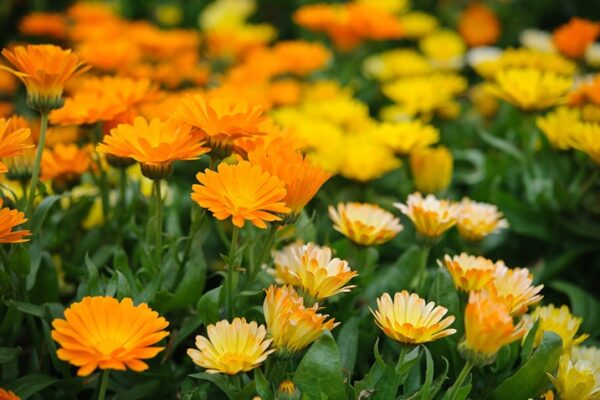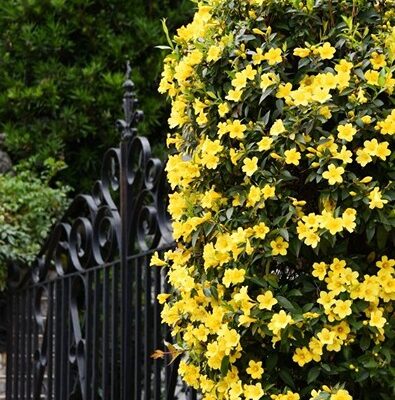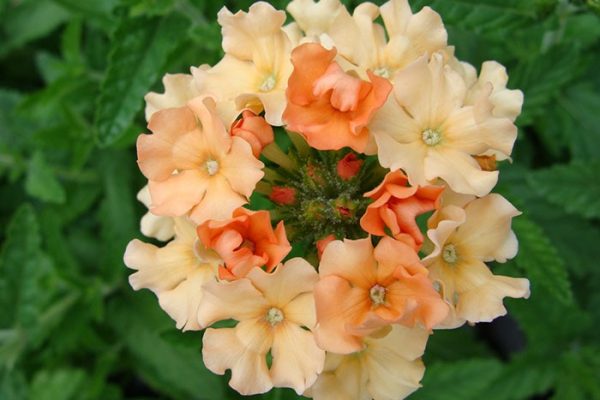10 Elegant Pink Flowering Trees for Back Yard
Pink flowering trees have the ability to enhance the beauty of any yard with their bright and cheerful appearance. These pink flowering trees vary in size, ranging from moderately tall ones to smaller shrub-like options that can be cultivated based on personal preference. The majority of pink flowering trees showcase their blossoms during the spring season, adding a delightful touch to the landscape. However, it’s important to consider other appealing features that can continue to captivate the eye once the spring blooms have faded. For instance, some trees offer ornamental fruits, like crabapples, that can bring autumnal charm to the yard. Alternatively, you may opt for a horse chestnut tree, which boasts distinctive nuts and can serve as a unique focal point. For a stunning yard adorned with pink flowering trees.
1: Crepe Myrtle
- Name: Crepe myrtle (Lagerstroemia indica)
- USDA Hardiness Zones: 6 to 9
- Light: Full sun
- Soil Needs: Average, medium moisture, well-draining
- Mature Size: 6-25+ ft. tall, 6-20 ft. wide
- Deer Resistant: Yes
This is one of the purplish pink flowering trees. Crepe myrtle, also spelled crape myrtle, is a remarkable tree that can reach varying heights depending on the specific type and the region it is grown in. The mature height of crepe myrtle, scientifically known as Lagerstroemia indica, can range from 10 to 25 feet or even taller in certain circumstances. Renowned as a prominent feature in the landscapes of the American Southeast, this tree boasts exceptional heat tolerance, making it well-suited to thrive in warmer climates.
One notable characteristic of crepe myrtle is its rapid growth rate, with an impressive annual increase of over 2 feet. This vigorous growth allows the tree to establish itself quickly, providing a substantial presence in the landscape within a relatively short period. Alongside its rapid growth, crepe myrtle showcases its distinct beauty throughout the year.
During the winter months, when many other trees are devoid of interest, crepe myrtle’s bark takes center stage. The bark exhibits an enchanting appearance, adding a touch of elegance and visual appeal to the landscape. This captivating feature enhances the overall winter aesthetics and contributes to the tree’s year-round allure.
Crepe myrtle’s versatility, heat tolerance, and vigorous growth make it a highly desirable addition to gardens and landscapes. Whether as a focal point or a stunning backdrop, this tree’s captivating presence, combined with its gorgeous winter interest, ensures that it will continue to be cherished and admired.
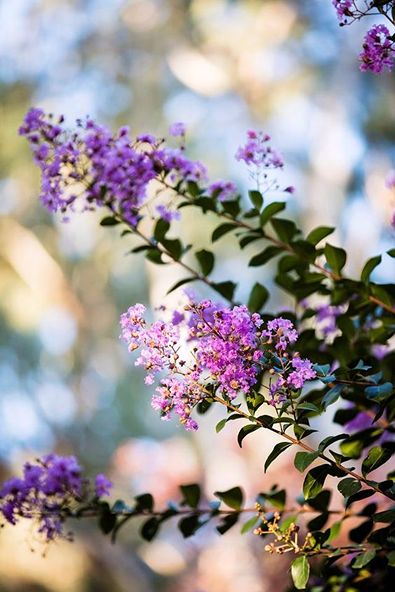
2: Weeping Higan Cherry
- Name: Higan cherry tree (Prunus x subhirtella ‘Pendula’)
- USDA Hardiness Zones: 5 to 8
- Light: Full sun
- Soil Needs: Average, medium moisture, well-draining
- Mature Size: 20 to 30 ft. tall, 15 to 25 ft. wide
- Deer Resistant: No
These weeping higan pink flowering trees, scientifically known as Prunus x subhirtella ‘Pendula,’ are a captivating cascading tree that brings charm and interest to any yard, particularly during the summer and fall seasons. It is widely recognized as one of the most popular ornamental cherry trees cultivated for its aesthetic appeal. The weeping higan tree exhibits a moderate growth rate, averaging around 1 foot of growth per year. At maturity, it can reach a height of 20 to 30 feet, making it a moderate to tall option among pink flowering trees.
One notable feature of the weeping higan tree is its glossy green leaves, which provide a lush backdrop during the growing season. As autumn approaches, these leaves undergo a striking transformation, turning vibrant yellow and adding an additional layer of visual interest to the tree. This autumnal display enhances the overall appeal of the weeping higan tree, making it a desirable choice for landscape enthusiasts.
The weeping higan tree’s cascading form, moderate growth rate, and attractive foliage make it an excellent option for adding vertical interest and unique character to a yard. Its pink blossoms, along with the vibrant yellow foliage in the fall, contribute to the trees overall charm and beauty.
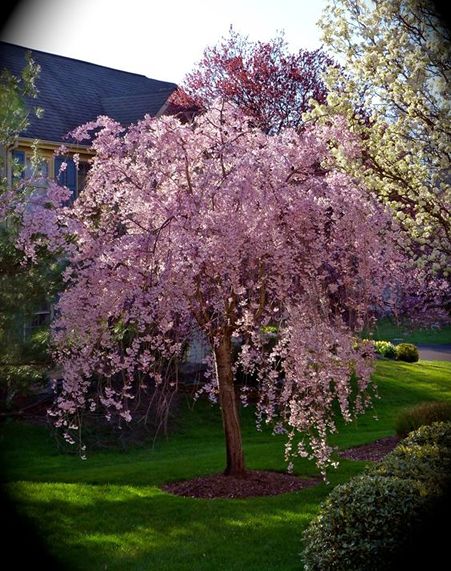
3: Kwanzan Cherry
- Name: Kwanzan cherry (Prunus serrulata ‘Kwanzan’)
- USDA Hardiness Zones: 5 to 8
- Light: Full sun
- Soil Needs: Average, medium moisture, well-draining
- Mature Size: 15–25 ft. tall, 13–26 ft. wide
- Deer Resistant: Yes
This is one of the pink and white flowering trees. The kwanzan cherry tree, scientifically known as Prunus serrulata ‘kwanzan,’ is a moderately growing tree with an average annual growth of 1 to 2 feet. It can reach a height of up to 25 feet, displaying an upright growth habit. One of the key highlights of this tree is its beautiful double-petaled pink blossoms, which are highly prized for their aesthetic appeal. Additionally, the kwanzan cherry tree exhibits an attractive coppery color in its early leaves, further adding to its visual charm.
However, it’s important to note that like many cherry trees, the Kwanzan variety has a relatively short lifespan due to susceptibility to various pests and diseases. Furthermore, it’s crucial to be aware that certain parts of the tree, including the leaves, stems, and seeds, contain toxins that can be harmful to both humans and pets.
Kwanzan cherry pink flowering trees remain a popular choice among gardeners and landscape enthusiasts for their exquisite pink blooms and early foliage color. Proper care and regular monitoring for potential issues can help ensure the longevity and safety of this visually captivating tree.
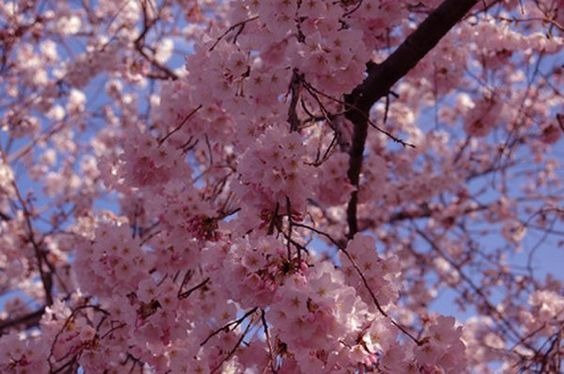
4: Saucer Magnolia
- Name: Saucer magnolia (Magnolia x soulangiana)
- USDA Hardiness Zones: 4 to 9
- Light: Full sun to partial shade
- Soil Needs: Average, medium moisture, well-draining
- Mature Size: 20 to 25 ft. tall, 20 to 25 ft. wide
- Deer Resistant: Yes
If you have a small yard, ‘Jane’ is the ideal choice for you. This magnolia variety, much like ‘Jane,’ is renowned for its stunning large pink blooms. Despite its captivating appearance, ‘Jane’ maintains a manageable size, making it suitable for compact spaces. It exhibits a medium growth rate of approximately 1 to 2 feet per year, ensuring that it remains in scale with smaller yards and gardens.
On the other hand, if you have a spacious property at your disposal, you might be drawn to the traditional saucer magnolias (Magnolia x soulangiana). These magnificent trees are also celebrated for their abundant, showy pink blooms. With their larger size, they make a striking statement and can serve as a focal point in a larger landscape. Their impressive stature and vibrant flowers create a visually captivating display, enhancing the overall beauty of expansive properties.
Whether you opt for ‘Jane’ or the traditional saucer magnolias, both varieties offer exceptional beauty and charm through their large pink blooms. Consider your yard size and available space when selecting the most suitable magnolia for your landscape, ensuring that it complements your surroundings and meets your aesthetic preferences.
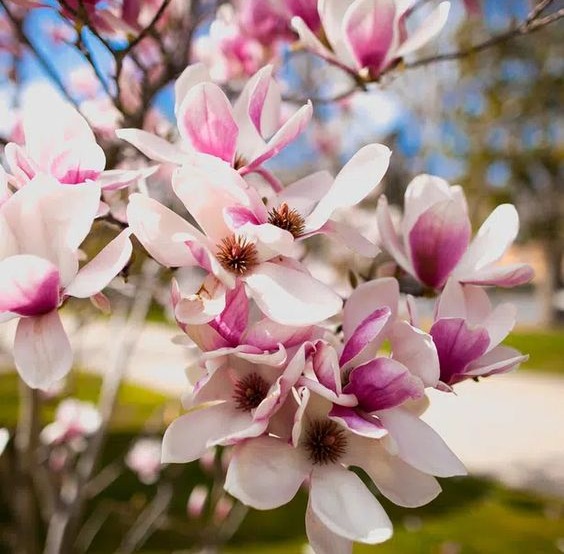
5: Magnolia 'Jane'
- Name: Magnolia ‘Jane’ (Magnolia liliflora ‘Reflorescens’ x stellate ‘Waterlily’)
- USDA Hardiness Zones: 4 to 8
- Light: Full sun to partial shade
- Soil Needs: Average, medium moisture, well-draining
- Mature Size: 8-12 ft. wide, 10-15 ft. tall
- Deer Resistant: Sometimes
‘Jane’ (Magnolia liliflora ‘Reflorescens’ x stellate ‘Waterlily’) is a relatively petite magnolia tree, measuring only 15 feet in height. Despite its small stature, the blossoms of ‘Jane’ are remarkably large, reaching an impressive size of up to 8 inches in diameter. This unique characteristic sets it apart from other trees of similar size. Another notable aspect of ‘Jane’ is its propensity to produce suckers, allowing for pruning and shaping as a multi-stemmed shrub if desired.
Similar to dogwood trees, magnolias thrive in acidic soil conditions. This means that if you have suitable soil acidity, you can successfully cultivate and enjoy both magnolias and dogwoods in your garden. ‘Jane’ features leathery green leaves that add to its overall appeal. As autumn approaches, these leaves undergo a captivating transformation, turning shades of yellow and bronze, providing a stunning display of fall colors.
Despite its modest height, ‘Jane’ magnolia makes a statement with its large, eye-catching blooms and versatile growth habit. Whether you prefer it as a small tree or as a multi-stemmed shrub, ‘Jane’ brings beauty and interest to your landscape. Its striking flowers, attractive foliage, and adaptability make it a desirable choice for gardens of various sizes.
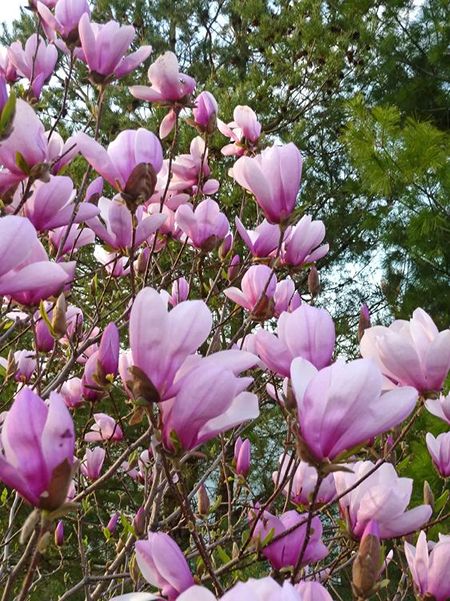
6: Pink Flowering Dogwood
- Name: Pink flowering dogwood (Cornus florida var. rubra)
- USDA Hardiness Zones: 5 to 9
- Light: Full sun to partial shade
- Soil Needs: Average, evenly moist, well-draining
- Mature Size: 15-30 ft. tall, 15-30+ ft. wide
- Deer Resistant: Yes
Among the commonly found dogwood trees in the United States, the pink flowering dogwood (Cornus florida var. rubra) is a native variety, reaching a height of approximately 30 feet. On the other hand, Cornus kousa hails from eastern Asia. These dogwood trees offer more than just their beautiful pink blossoms in the spring season. As autumn arrives, their foliage undergoes a captivating transformation, turning purplish in color. Additionally, both varieties produce berries that attract birds, enhancing the overall appeal of the trees, and boast intriguing horizontal branching patterns.
While both the pink flowering dogwood and Cornus kousa offer attractive berries, they differ in appearance. The berries of Cornus florida resemble beads, while those of Cornus kousa have a raspberry-like appearance. These distinct characteristics add further visual interest to the trees and contribute to their overall charm.
Whether you opt for the native pink flowering dogwood or the exotic Cornus kousa, you can enjoy the delightful pink blossoms in spring, the vibrant foliage in fall, the bird-attracting berries, and the captivating branching patterns. Each variety brings its own unique characteristics to your landscape, offering a touch of natural beauty and fascination throughout the seasons.
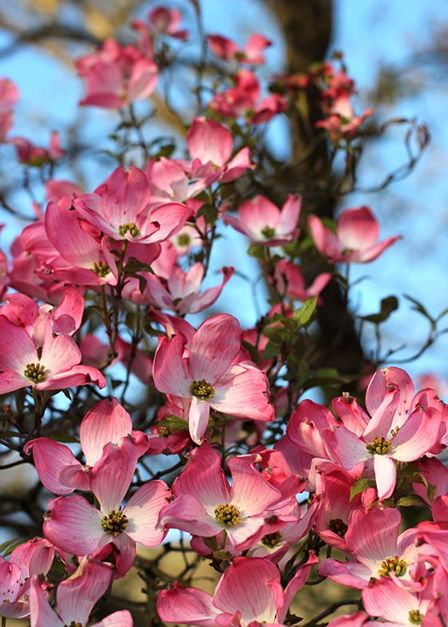
7: Crabapple
- Name: Crabapple (Malus spp.)
- USDA Hardiness Zones: 4 to 8
- Light: Full sun
- Soil Needs: Rich, loamy, well-draining
- Mature Size: 15–20 ft. tall, 12–20 ft. wide (occasionally larger)
- Deer Resistant: No
Opinions on the fruits that follow the flowers of crabapple trees (Malus spp.) can vary among individuals. While some may find them messy and undesirable, others appreciate their presence for the attraction they bring to wild birds, especially during the winter months. If you enjoy observing birds in your yard and value their presence, you might consider tolerating the potential mess associated with crabapple fruits. Not only do these fruits serve as a food source for birds, but they can also add a touch of ornamental value to your landscape.
Among the different varieties of crabapple trees, the popular Malus sargentii stands out with its pink buds that eventually open to reveal delicate white blossoms. However, if you specifically desire pink flowers, the recommended choice would be Malus ‘Robinson’ which can reach a height of 25 feet. It’s important to note that while crabapple trees offer aesthetic appeal and attract wildlife, their fruits can be toxic to animals. Appropriate precautions should be taken to ensure the safety of pets or other animals in the vicinity of these trees.

8: Flowering Almond Tree
- Name: Flowering almond (Prunus triloba ‘Multiplex’)
- USDA Hardiness Zones: 3 to 7
- Light: Full sun
- Soil Needs: Fertile, medium moisture, well-draining
- Mature Size: 10-15 ft. tall
- Deer Resistant: Yes
The Prunus genus encompasses a diverse range of trees, including both ornamental varieties and those cultivated for their edible fruits. Among these, the flowering almond tree (Prunus triloba ‘Multiplex’) stands out as a captivating ornamental almond tree. This particular cultivar, known as ‘Multiplex’, exhibits a growth rate of approximately 1 foot per year, ultimately reaching a height of up to 15 feet. Notably, ‘Multiplex’ is renowned for its abundant double flowers, which lend an exquisite visual display to the tree. Unlike some other almond trees, this cultivar does not bear edible fruit.
For those seeking a smaller option, there are dwarf flowering almond trees (Prunus glandulosa) available. These compact varieties reach a maximum height of only 5 feet, making them an ideal choice for more confined spaces. It’s worth noting that while the flowering almond tree offers an attractive aesthetic, it is more tolerant of colder temperatures compared to flowering cherry trees.
However, it’s important to be aware that flowering almond trees, including both the ‘Multiplex’ and dwarf varieties, are toxic to humans and animals. Caution should be exercised when handling any parts of the tree, as they can pose a potential health risk.
The flowering almond tree, with its showy blossoms and distinct growth characteristics, adds a touch of elegance and beauty to any landscape. While it does not produce edible fruit, its stunning double flowers and cold tolerance make it a noteworthy choice for those seeking a visually appealing ornamental tree.
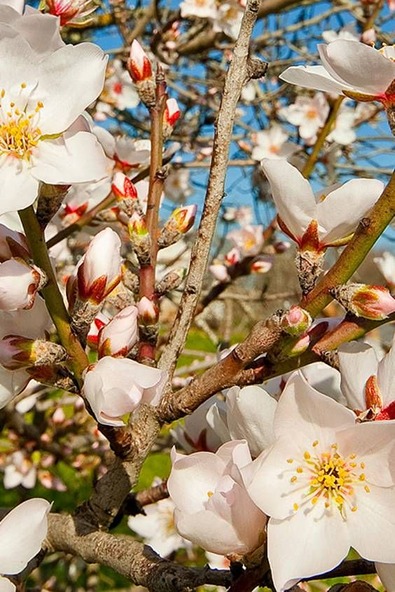
9: Eastern Redbud
- Name: Eastern redbud (Cercis canadensis)
- USDA Hardiness Zones: 4 to 8
- Light: Full sun to partial shade
- Soil Needs: Average, medium moisture, well-draining
- Mature Size: 20 to 30 feet tall, 30 to 35 feet wide
- Deer Resistant: No
The Eastern redbud (Cercis canadensis) is a captivating tree known for its reddish-pink buds, which, upon opening, reveal striking dark pink flowers rather than red. With a mature height of approximately 30 feet, the Eastern redbud steadily grows at a rate of 1 to 2 feet per year. One notable characteristic of this tree is its early spring flowering, which occurs even before the leaves have fully emerged.
A specific cultivar of the Eastern redbud called ‘Covey’ exhibits a weeping growth habit, adding a unique visual appeal to the tree. This weeping form enhances its beauty and creates a graceful silhouette. In addition to its charming flowers, the Eastern redbud provides an additional visual treat during the autumn season. It displays gorgeous fall foliage, showcasing a range of vibrant colors that continue to captivate and add interest to the landscape.
The Eastern redbud, with its alluring buds, dark pink flowers, and appealing growth pattern, makes a splendid addition to any garden or yard. Its early spring blooms offer a delightful burst of color and serve as a precursor to the arrival of lush foliage. Moreover, the tree’s ability to showcase stunning fall colors ensures year-round visual enjoyment.

10: Red Horse Chestnut
- Name: Red horse chestnut (Aesculus × Carneau)
- USDA Hardiness Zones: 5 to 8
- Light: Full sun to partial shade
- Soil Needs: Average, medium moisture, well-draining
- Mature Size: 30-40 ft. tall
- Deer Resistant: Yes
The red horse chestnut (Aesculus × Carneau) is a notable tree that stands tall, reaching a height of approximately 40 feet when fully mature. Initially displaying a red hue, the flowers of this tree gradually transform into a deep pink shade as they develop. The inclusion of the “x” in its botanical name signifies that the red horse chestnut is a hybrid, resulting from a cross between the red buckeye (Aesculus Pavia) and the common horse chestnut (Aesculus hippocastanum).
One of the distinctive features of the red horse chestnut is its spiky flower clusters, which measure between 6 to 8 inches in length. These clusters emerge from a backdrop of dark green foliage, providing an appealing contrast and adding ornamental value to the tree. While the flowers themselves are visually captivating, the tree’s namesake nuts also contribute to its overall allure. The shiny nuts, measuring approximately 1 inch in both width and height, are a noteworthy characteristic. However, it is important to note that these nuts are toxic and should not be mistaken for edible chestnuts. Unlike edible chestnuts, horse chestnuts possess a fleshy, bumpy husk with a distinct wart-covered appearance.
With its impressive height, vibrant flowers, and unique nuts, the red horse chestnut makes a striking addition to any landscape. It adds a touch of elegance and visual interest, showcasing its blossoms and foliage throughout the growing season. However, it is essential to exercise caution and prevent any consumption of the tree’s toxic nuts, ensuring the safety of humans and animals alike.


